World Haemophilia Day
Lighting up red around Australia
www.haemophilia.org.au

Rare Disease Day
What it means to be very rare
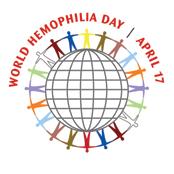
FIFO workers
Managing your bleeding disorder
HAEMOPHILIA FO UND ATION AUSTRALIA Number 225 MARCH 2024
3
4
5
6
8
9
10
Haemophilia Foundation Australia
Registered No.: A0012245M
ABN: 89 443 537 189
Street address:
7 Dene Avenue Malvern East, Victoria, Australia 3145
Postal address:
PO Box 1208, Darling, Victoria, Australia 3145
Tel: +61 3 9885 7800
Freecall: 1800 807 173
Fax: +61 3 9885 1800 hfaust@haemophilia.org.au www.haemophilia.org.au
Editor: Suzanne O’Callaghan
Read National Haemophilia online https://www.haemophilia.org.au/ nationalhaemophilia

Damon Courtenay Memorial Endowment Fund
Funding Round Open 2024
The Damon Courtenay Memorial Endowment Fund (DCMEF) was established by Haemophilia Foundation Australia in 1994 with financial support from the late Bryce Courtenay and the late Benita Courtenay in memory of their son, Damon.
• $10,000 in total to be distributed
• There is no limit to what you can apply for; however, up to $2,000 is more likely to be successful
• Who can apply? Anyone with a bleeding disorder or affected by a bleeding disorder who resides in Australia may apply for a grant
• Funding may be used for projects, services and/or care, or an activity aimed at improving the physical and emotional wellbeing and independence of recipient/s.
For detailed information and application forms:
• HFA website: www haemophilia.org.au/DCMEF
• Request by email hfaust@haemophilia.org.au
• Telephone HFA on 1800 807 173

2
HAEMOPHILIA FO UND ATION AUSTRALIA CONTENTS National Haemophilia 225, March 2024
From the President
Changes at HFA
World Haemophilia Day
Rare Disease Day 2024
About Glanzmann thrombasthenia
Living with Glanzmann thrombasthenia
Growing up with Glanzmann thrombasthenia
Why is PROBE important?
AHCDO update
FIFO and bleeding disorders
Mental health and support
Women and peer support
HFA has a new website
Factored In: youth leadership
12
13
14
16
18
21
22
0818-4933 (Print) ISSN: 2981-9148 (Online)
ISSN:
image: Akil Mazumder for Pexels.com Applications close 30 June 2024
made by December 2024
Stock
Distributions
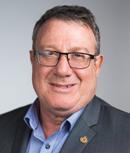 Gavin Finkelstein
President, Haemophilia Foundation Australia
Gavin Finkelstein
President, Haemophilia Foundation Australia
Another exciting year ahead and the staff have hit the ground running in 2024. I am happy to share that HFA funding has been reinstated by the Department of Health and the National Blood Authority until 2027. This is a big relief for HFA, our stakeholders, community and health professionals.
WFH WORLD CONGRESS
Australia will be well-represented at the World Congress in Madrid in April 2024. A number of our Haemophilia Treatment Centre health professionals will be attending and presenting. I will be attending the National Member Organisation training in the days leading into Congress and the General Assembly, as well as attending Congress. HFA Executive Director (Acting), Natashia Coco, will also be attending Congress and Suzanne O’Callaghan, Policy Research and Education Manager, has been invited to speak on Creating supportive networks and advocacy initiatives in the Women and Girls with Bleeding Disorders track on Tuesday 23 April 2024. We look forward to hearing the reports from Australian delegates in the next edition.
WORLD HAEMOPHILIA DAY
Every year on 17 April World Haemophilia Day is recognised worldwide to increase awareness of haemophilia, von Willebrand disease and other inherited bleeding disorders. The 2024 international theme is Equitable access for all: recognizing all bleeding disorders.
Australia has a number of sites lighting up in red on the day. See www.haemophilia.org.au/WHD for a list of sites.
From the President
RARE DISEASES
In this issue of National Haemophilia we also feature Rare Disease Day and personal stories that two community members with Glanzmann thrombasthenia have generously shared with us. Some bleeding disorders are very rare and people affected can feel very isolated. We are grateful to Allison and Elizabeth for explaining the challenges they and their family live with and highlighting the work that still needs to be done around rare diseases.
HFA WEBSITE
The new HFA www.haemophilia.org.au website went live in January 2024. The site features improved navigation, and it is much easier to find many of our resources. Your local Foundation sites have also had a makeover and gone live recently. Please bear with us as the staff fine tune a few aspects of the site.
DON’T FORGET THE PROBE STUDY
HFA is building evidence about the needs of men and women affected by haemophilia in Australia with the PROBE Australia Study. This is an important study on the impact of haemophilia and we would really appreciate your help, particularly as we enter a time of further advocacy around new treatments. For good credible data, we need several hundred survey responses. Please consider participating, if you haven’t already, and perhaps inviting your family and friends to complete the survey – we also need equal numbers of people without a bleeding disorder as a comparison group. See page 12 for details.
3
National Haemophilia 225, March 2024
Changes at HFA

M: 0403538109
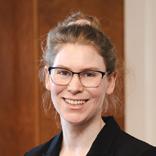
I am honored to take on the role of Executive Director (Acting) for HFA. For those who don’t know me, I have been with HFA for 20 years, working in the area of conferences and events, fundraising, development and relationships. Stepping up to this role is a challenge and a privilege to represent the bleeding disorders community.
Outside work I enjoy watching AFL football (go Tigers) and basketball and love to cook. I am married to Damian and we have 2 teenagers, Raf and Giselle. As a family we love to have adventures together and catch up with family and friends.
Our hardworking HFA team consists of Suzanne O’Callaghan – Policy Research and Education Manager, Poppy Sparsi – Administration Manager, Kevin Lai – Accountant, and Pauline Hill is also joining us, taking on the role of Digital Communications Manager.
MEET PAULINE
HFA is pleased to welcome Pauline Hill as our Digital Communications Manager. You may already be familiar with Pauline – working on a contractual basis, she was at our Conferences in 2021 and 2023 and has been looking after our social media and e-newsletters for over two years now. She has even contributed a few articles to National Haemophilia. She is excited to make the position permanent. ‘It has been so lovely working with the team at HFA and getting to know the bleeding disorders community. There is so much change on the horizon. I’m really looking forward to the next chapter.’
Pauline has been working in marketing and design for over 15 years, developing a passion for all things digital. Her desire to see her work benefit a community led her to HFA.
‘I have found that my best work always comes when I feel connected to a cause. HFA’s work for the Australian bleeding disorders community is inspiring to see, and so gratifying to be a part of.’
Outside of work, Pauline is a self-confessed ‘greenie’, with an electric car and solar panels on her roof. She keeps herself busy caring for three horses, helping at her parent’s farm, and trying to keep up with her 2-year-old son.
4 National Haemophilia 225, March 2024
Natashia Coco ncoco@haemophilia.org.au
Pauline Hill phill@haemophilia.org.au

Every year on 17 April World Haemophilia Day is recognised worldwide to increase awareness of haemophilia, von Willebrand disease and other inherited bleeding disorders. This is a critical effort since with increased awareness comes better diagnosis and access to care for the millions who remain without treatment.
World Haemophilia Day was started in 1989 by the World Federation of Hemophilia (WFH), which chose 17 April as the day to bring the community together in honour of WFH founder Frank Schnabel’s birthday.
In 2024 the international theme is Equitable access for all: recognizing all bleeding disorders. The World Federation of Hemophilia (WFH) vision of Treatment for All is for a world where all people with inherited bleeding disorders have access to care, regardless of their type of bleeding disorder, gender, age, or where they live.
Did you know, WFH estimates that over 75% of people living with haemophilia worldwide have not yet been identified and diagnosed.
The World Federation of Hemophilia, with the support of volunteers from around the world, does remarkable work to improve access to diagnosis, treatment, care and support for people with bleeding disorders in less well-resourced countries with their GAP and Twinning Programs and the Cornerstone Initiative. For more information on their programs visit www.wfh.org
Haemophilia Foundation Australia is a WFH member organisation and many Australian volunteers have been involved with WFH programs. HFA has supported many programs over the years and participated in the WFH Twinning Program and various committees that work to achieve the objectives of WFH.
In Australia, our community is fortunate to have access to a range of treatments, care and services. During recent times, some new haemophilia therapies available in Australia have led to fewer or no bleeds and greatly improved the quality of life of those who have been able to use them. We look forward to more novel therapies in the future for everyone.
Leading into the day HFA will showcase stories recognising all bleeding disorders –keep a eye on our socials.
LIGHT IT UP RED
We are excited to have locations and landmarks in every state and territory in Australia Lighting up Red in support of World Haemophilia Day.
Check on our website for the list of locations in your area and share photos on our social media platforms.
MORE INFORMATION
For more information and locations, visit the World Haemophilia Day page on the HFA websitewww.haemophilia.org.au/WHD24
5 National Haemophilia 225, March 2024
Rare Disease Day 2024

This year Rare Disease Day is celebrated worldwide on 29 February to raise awareness and generate change for people with rare diseases.
Although the campaign represents a diverse group of people, it is united in purpose and aims to work globally towards equity in social opportunity, healthcare and access to diagnosis and therapies for people living with a rare disease.
The 2024 theme of Rare is many. Rare is strong. Rare is proud reminds us how important it is to come together and connect as a community. This is an opportunity to share personal stories and acknowledge the challenges for our community members who live with a rare bleeding disorder.
WHAT IS A RARE DISEASE?
In Australia, a disease is considered rare if it affects less than 5 in 10,000 people.
Around 8% of Australians (2 million people) live with a rare disease.
About 80% of rare diseases are genetic. Diagnosis can often take time because these conditions are complex and doctors do not see them often.1
Haemophilia is considered rare. Approximately:
• 1 in 6,000 males has haemophilia A
• 1 in 30,000 males has haemophilia B
Researchers are still gathering data on how many females are affected by haemophilia.
6 National Haemophilia 225, March 2024 RARE DISEASE DAY 2024
Some bleeding disorders are very rare.
For example, factor X (10) deficiency only affects 1 in a million people.
Type 3 VWD is the rarest form of von Willebrand disease, occurring in 1 in 500,000 people in countries like Europe and the USA.
Sometimes these rare bleeding disorders are not well-recognised. While only several hundred people have been diagnosed with Glanzmann thrombasthenia worldwide, it is thought that others are undiagnosed.2
PERSONAL STORIES
In this issue of National Haemophilia, Allison tells her story of living with Glanzmann thrombasthenia and Elizabeth shares her experience of being the parent of a teenage daughter who is growing up with the condition. They both explain what they have learned about managing the challenges and living well.
Sharing personal stories is an important way to help people with rare diseases feel connected. It can also help the wider community to understand better what it is like to live with a rare disease.
You may have seen some other personal stories about living with very rare bleeding disorders on our social media platforms in the lead up to Rare Disease Day.
Our thanks to Allison, Elizabeth and our other community members with rare bleeding disorders for sharing their personal stories.
Many people with rare diseases speak of feeling isolated. They may never have met another person with their condition. If they are the first in their family with the condition, it may have taken a long time for them to be diagnosed. Women and girls with haemophilia also talk of not being believed because of the common assumption that only males have haemophilia.
TREATMENTS
Treatment development is another issue. When rare diseases are very rare and numbers are small, this can mean that the development of new and highly effective treatments is slow. There may even be no treatment that specifically targets that condition. For example, while there has been great worldwide excitement about the new therapies for haemophilia and the difference they make to reducing bleeds and quality of life, there is not yet a specific clotting factor concentrate that is suitable to treat factor V (5) deficiency and fresh frozen plasma may be used for treatment instead.
HOW CAN YOU HELP?
You can help to raise awareness by sharing the stories of people with bleeding disorders through your personal networks.
Do you have a story...
about living with a rare bleeding disorder you would like to share?
Visit the SHARE YOUR STORY section on the HFA website to tell us morewww.haemophilia.org.au/shareyourstory
For more information on Rare Disease Day, visit: www.rarediseaseday.org
REFERENCES
1. Australian Government. Department of Health. What we’re doing about rare diseases. https://www.health.gov.au/healthtopics/chronic-conditions/what-were-doing-about-chronicconditions/what-were-doing-about-rare-diseases Accessed 20 February 2024
2. Orphanet: the portal for rare diseases and orphan drugs. https://www.orpha.net/ Accessed 21 February 2024
7 National Haemophilia 225, March 2024
About Glanzmann thrombasthenia

Glanzmann thrombasthenia is a very rare hereditary platelet function disorder that affects the way that platelets work in the body.
Platelets are cells in the blood that help with blood clotting. When a blood vessel is injured, platelets stick or clump together to form a ‘platelet plug’ at the site of the injury and to help stop the bleeding.
In Glanzmann thrombasthenia there is a deficiency of a protein on the surface of the platelet. As a result, platelets do not form a strong plug at the site of an injury, leading to a tendency to bleed for longer than normal or bruise easily.
Symptoms vary from one person to another and severity can range from mild to severe:
• Abnormal bleeding with surgery, circumcision, or dental work.
• Children experience bruising, nose bleeds and bleeding in the mouth and gums.
• Women may experience heavy or prolonged menstrual bleeding (menorrhagia), bleeding during ovulation and abnormal bleeding during or after childbirth.
• On rare occasions gastrointestinal bleeding.1,2
The Haemophilia Treatment Centre will develop a treatment plan to manage bleeding with the person that is specific to their situation.
Glanzmann thrombasthenia is inherited in an autosomal recessive pattern. This means it occurs in the unusual situation where both parents carry the gene change causing the disorder, usually without symptoms, and each pass the gene change onto their child, who then has the disorder. It affects both males and females.3
Thanks to Dr Jane Mason, Director, Queensland Haemophilia Centre, for reviewing this information.
REFERENCES
1.World Federation of Hemophilia. What are inherited platelet function disorders? WFH: Montreal, 2023. https://www1.wfh.org/ publications/files/pdf-1336.pdf
2.Canadian Hemophilia Society. Types of platelet function disorders.
https://www.hemophilia.ca/types-of-platelet-function-disorders/
3. National Organization for Rare Disorders (NORD). Glanzmann thrombasthenia. 2023.
https://rarediseases.org/rare-diseases/glanzmann-thrombasthenia/
Stock image: Roger Brown for Pexels.com
8 National Haemophilia 225, March 2024 RARE DISEASE DAY 2024
Living with Glanzmann thrombasthenia
Allison’s story

Allison is in her mid-40s and was diagnosed with Glanzmann thrombasthenia at birth. She talked to HFA about her experiences and what she has learned from living with this very rare bleeding disorder.
Learn more about Glanzmann thrombasthenia on page 8
‘I have learned that while you need to be careful, you do also need to live your life.’
ALL IN THE FAMILY
‘When I was born, they tested me for Glanzmann thrombasthenia as I had an older sister with the disorder. When I was diagnosed it was easier for my parents to understand as I had an 18-month-old sister who had the condition and they had already started their learning journey.’
TREATING A RARE DISORDER
The experience of Glanzmann thrombasthenia varies from person to person and treatment requirements for each individual can take time to determine.
‘My bleeding is generally associated with periods and injury or surgery, and not spontaneous, that is, with no obvious cause.
‘We had great support from the children’s hospital growing up, with an annual check-up. We were hospitalised periodically, but less than ten times. At this stage I have not had any significant injuries or surgeries. But for me even simple procedures, like a colonoscopy, require factor with the risk of bleeding.’
Initially Allison had treatment with platelet transfusions but developed antibodies to them, so that the treatment no longer worked. Since then, she has had treatment with recombinant coagulation factor VIIa (Novoseven ® ) with minor procedures, and tranexamic acid for day-to-day bleeding, when needed.
GROWING TO ADULTHOOD
‘I always felt different to everyone else and went to great lengths to hide my disorder. The main outward sign was the amount of bruising all over my body. This proved to be very challenging and did not help my selfconfidence.
Allison played netball until she was 12 years old and then transitioned to tennis as a non-contact sport. ‘I am very prone to injury and recovery always takes longer for me, as I have a tendency for swelling and can’t take anti-inflammatory medication to support healing.’
‘Going through puberty was one of the tougher times in life. I was hospitalised when I got my first period due to the inability to control my bleeding and excessive loss of blood. Since then this has caused issues from time to time and has meant that I have had to be on hormones to control bleeding my whole life.’
‘One of the most difficult things for me to accept has been the inability to have my own children. Even to extract eggs was too risky for my level of severity. Others with the condition have been able to have children due to their lesser severity. I am lucky enough to have had twins with an egg donor and surrogate.’
LIVING WELL
‘I have learned that while you need to be careful, you do also need to live your life. Make sensible decisions about what you should and shouldn’t do, factoring in the risks. Learn about your body and its limitations. Live life making good choices.
‘Living with a rare disorder can be quite isolating as nobody you know is like you and can understand what everyday life can be like for you. This is why it is important to have a supportive network of people around you - and share with the people who are close to you so they can also understand and support you in all you do in life.’
Stock image: Adrienn for Pexels.com
9 National Haemophilia 225, March 2024 RARE DISEASE DAY 2024
Growing up with Glanzmann thrombasthenia

Elizabeth’s teenage daughter Grace has Glanzmann thrombasthenia. Elizabeth spoke with HFA about what it was like to find that your child has a very rare bleeding disorder and their family experiences as Grace grows up.*
To find out more about Glanzmann thrombasthenia, see page 8
‘Grace is our only daughter and has Glanzmann thrombasthenia. She has platelets in her blood but they don’t function properly, so she has a treatment plan of “don’t get hurt”!’
Treatment for Grace involves tranexamic acid as a starting point if she has mouth, nose, ear or face bleeds, and also for her periods. When things get more serious and she needs more help with clotting, her medication steps up to recombinant factor VIIa (Novoseven®).
10 National Haemophilia 225, March 2024
RARE DISEASE DAY 2024
AN UNEXPECTED DIAGNOSIS
The road to diagnosis took 9 months and several referrals to specialists. As a premature baby, Grace needed regular heelprick tests when she was born. ‘Her feet ended up swelling like little blood balloons,’ said Elizabeth. ‘When she cried what I now know are petechiae would burst in her face, so she would have bloom of dots on her face.’
Their GP referred her to a paediatrician, who sent her to a dermatologist at the children’s hospital. ‘The questions slowly evolved. After a bruise on her hip, they wanted to be thorough and did a biopsy so they could test from A to Z. They were explaining every disease they were testing for and made a comment, don’t worry it won’t be Glanzmann’s, it’s very rare, and then it came back as Glanzmann’s.’
‘We were first time parents and it felt like it was one long learning curve. But when she was diagnosed, it was good to know that if she cried and the petechiae happened, her face wasn’t sore or injured because the burst blood vessels didn’t physically hurt her.’
INHERITANCE –WHAT ARE THE ODDS?
When Elizabeth and her husband investigated having more children, they discovered just how astonishing it was that Grace inherited the gene alteration causing Glanzmann thrombasthenia from both of them. They are not in any way related to each other. Genetic testing confirmed they were both carriers. ‘If only one of us had given her the gene alteration for Glanzmann’s, she just would have been a carrier and we never would have known.’
It was recommended that Elizabeth and her husband use IVF to have more children, but it was too expensive to pursue after the first round was unsuccessful. ‘We’re insanely happy and proud to have our little miracle. She is an amazing human being. We tried to give her a sibling but it just didn’t work.’
MANAGING RISKS
Now that Grace is a teenager, managing her bleeding disorder has become part of normal life. There are routines, areas that are relaxed, and some rules –‘she needs to be safe about what she is doing.’ She participates in sport but avoids contact sports –anything where she could be hit by a bat or a ball, as well as by a person, and that includes when she is sitting out. ‘She does a lot of skill-based sport, but kids can be boisterous and she needs to make sure she is around kids who are careful. She has amazing friends now who rally around her if anything goes wrong, like if she has a bleed.’
‘Grace is a typical teenager. She loves life, she loves fishing and camping and loves being outdoors. As a parent, I try to make as many opportunities as I can for her.’ This has included working carefully with her school to make sure she can have first aid and ice any bleeds easily and quietly, ‘so she gets the most out of her classes, doesn’t feel like she is imposing on anyone or feel like she is being noticed.’
WHAT’S IMPORTANT?
‘We’ve learned to find fun things that you can do as an individual and as a family that doesn’t feel like I can only do this. When things are hard, you need something to look forward to. But things aren’t always hard!’
‘And you’re not alone. It’s just life, everyone has their ‘thing’ – it could be a nut allergy or living remotely and they deal with that in their way. And for Grace, it’s just being careful.’
Stock image: Emma Bauso for Pexels.com
*Elizabeth and Grace are not their real names
11 National Haemophilia 225, March 2024
Why is PROBE important?


HFA is building evidence about the needs of men and women affected by haemophilia in Australia and we would really appreciate your help.
WHAT IS THE PROBE STUDY?
The PROBE Australia Study is co-ordinated by Haemophilia Foundation Australia and is an internationally recognised and validated questionnaire. It collects data on the impact of haemophilia on the quality of life of both men and women who are affected, either because they have haemophilia or carry the gene. It compares their experience to people who do not have a bleeding disorder.
So far we have only had around 150 men and women complete the PROBE survey – we need at least 400 for good data.

WHAT DO WE DO WITH THE DATA?
PROBE data is high quality and credible and we use it in many ways. You may have seen some of the data from the 2019 PROBE Australia Study in reports and conference presentations. Some examples include:
• Advocacy to government about new treatments and services
• The HFA Getting Older report, about issues with physical function and pain, mild haemophilia, women, hepatitis C
• The plenary on mild haemophilia at the 2023 Australian Conference
• International meetings to discuss the issues for people with mild haemophilia
• The HFA poster on 2019 PROBE data at the 2024 WFH Congress (a peer-reviewed publication).
HOW CAN YOU HELP?
Please consider completing the current PROBE Australia survey as soon as possible – and you don’t need to have a bleeding disorder to contribute!
If you don’t have a bleeding disorder, you can be a health professional, or someone interested in haemophilia. The comparison group is a slice of the Australian general community.
PROBE is voluntary and anonymous, so it is up to you – but we would really value your support.
Who can complete the survey?
Adult (18 yrs+) men and women living in Australia
• Who have haemophilia/carry the gene
• OR who do NOT have a bleeding disorder (comparison group)
How to do the survey
It’s very easy! Go to:
• myprobe.org for the web version
• Or download the myPROBE app from Apple Store or Google Play (Android)
• Or ask HFA for a print survey pack
If you have already done the survey, perhaps you could share it with family and friends and encourage them to complete it too.
QUESTIONS?
Visit www.haemophilia.org.au/probe-australia-study
Or contact Suzanne at HFA:
E: socallaghan@haemophilia.org.au T: 1800 807 173
12 National Haemophilia 225, March 2024
AHCDO update
Andrea Johannessen
AHCDO ANNUAL GENERAL MEETING
The Australian Haemophilia Centre Directors’ Organisation (AHCDO) held its Annual General Meeting in November 2023.
A new Executive Committee was elected:
• Chairperson - Dr Stephanie P’ng (Fiona Stanley Hospital, WA)
• Deputy Chairperson - Dr Jane Mason (Royal Brisbane and Women’s Hospital, QLD)
• Treasurer - Dr Chee Wee Tan (Royal Adelaide Hospital, SA)
• Research Committee ChairpersonDr Sam Hitchins (Royal Hobart Hospital, TAS)
• General Member - Dr Chris Barnes (Royal Children’s Hospital, VIC)
• General Member - Dr Liane Khoo (Royal Prince Alfred Hospital, NSW)
EDUCATION DAY
AHCDO held a half-day Education Day for Director and Associate Members in November 2023 at the Melbourne Convention Centre. We had great attendance from our Haemophilia Treatment Centres. The opening sessions were focussed on the treatment of women with known and unknown bleeding disorders in pregnancy, labour, and the postpartum period, using a case series of two patients. Thank you to Dr Briony Cutts for sharing the cases of two patients to provide AHCDO members with a great insight into these complicated cases. Professor Sonia Grover, a paediatric and adolescent gynaecologist, spoke about the options available to women with bleeding disorders to manage menstruation. Suzanne O’Callghan presented an update on the 2020 PROBE Australian data.
Our AHCDO members are Heads of Haemophilia Treatment Centres so we had a session focused on Mental Health at Work with a presentation by

Dr Sarah Dawkins and the opportunity for much discussion. Sarah focussed on identifying strategies for wellbeing at work for yourself and for others, identifying and managing mental health hazards and managing risks.
We finished the day with presentations from our AHCDO Research Fellows and will provide those research outcomes in future editions.
VON WILLEBRAND DISEASE
AHCDO has recently published ‘Recommendations for management of type 3 von Willebrand disease in Australia on behalf of the Australian Haemophilia Treatment Centre Directors Organization (AHCDO)’ and it is available on our website www.ahcdo.org.au. If you have any questions or feedback, please contact AHCDO at info@ahcdo.org.au.
GENE THERAPY ROADMAP
AHCDO developed the Gene Therapy Roadmap to provide a Clinical Implementation Plan that sets out AHCDO’s position on the preferred approach to implementation of gene therapy for haemophilia in Australia, with a focus on patient needs that is informed by clinical experience.
AHCDO has progressed implementing the Gene Therapy Roadmap with a Gene Therapy Workshop in August 2023 attended by all members of the HTC team. The Workshop was on the day prior to the HFA National Conference so we were able to maximise attendance. We were grateful to have Dr Glenn Pierce present on the global perspective of gene therapy for bleeding disorders, which was a great introduction for the session. Many of our HTCs and Australian patients have been involved in developing this technology and it was a very valuable discussion. The Roadmap can be viewed from the AHCDO website - www.ahcdo.org.au.
Dr Andrea Johannessen is AHCDO Executive Officer
13 National Haemophilia 225, March 2024
FIFO and bleeding disorders
Beryl Zeissink
As a FIFO, what do you need to think about?
FIFO means ‘Fly in Fly out’ and DIDO ‘Drive in Drive out’. If you are a FIFO/DIDO worker with a bleeding disorder, what are the important things you need to think about, when your employer flies you to your work location that maybe either remote, international, temporary or require movement to several sites?
Similarly to any travel, FIFO work does require planning and a discussion with your Haemophilia Treatment Centre (HTC). Sometimes there are extra layers of planning that you should do, that you may not have considered.
Often positions held by workers can be varied. Is your work going to be heavy manual labour, involve risky activities, be administrative, housekeeping? Or you could even be a nurse! Typically, 12-hour shifts can be worked for a total of 7 days; however, there are varying patterns of work, with being in the field for 1 to 4 weeks before you return home for some down time. There can be extreme temperatures and there can be a psychological impact with time away from family and change in work/life balance.
HEALTH ASSESSMENT
Most employees are required to undergo a medical assessment to ensure they can meet the physical and mental challenges of the work. Assessments may include chest X-rays (especially in mining sites), drug and alcohol testing, fitness evaluations, hearing, visual and overall health checks. The level of health assessments prior to working for a company may vary or be dependent on the type of work you will do. Declaring your bleeding disorder should be considered, keeping in mind the risk involved if you do not declare this, if there is an accident or emergency.
WORK SITE TIPS
When travelling to work sites, if you are driving you should consider having a portable/camping refrigerator to keep your medication cool. Be aware of the temperature ranges you need to keep your treatment product at, and time (if any) it can be out of the fridge. You need to remember that extremes in temperature may make your treatment not as effective.
If you are flying, you will usually have to bring your treatment in and out with you each time you fly. Other people may use your room when you are back home, so it may not be possible to leave your treatment there when you fly home.
You need to remember, if you use treatment, that you replace it when you get ‘home’. You don’t want to have no treatment available next time you need to use it.
A tip is to have at least 2 doses of treatment product with you, depending on where you are, and how long you will be there:
• One for an initial serious bleed dose
• One follow-up dose, until you can return home.
These amounts may differ if you have mild, moderate, or severe bleeding disorders. You can discuss what they recommend you have with you with your HTC.
Don’t forget a tourniquet
You may find it easier to keep all your supplies together in a small soft esky or lunch bag with an ice pack when travelling. Remember to put it into a fridge when you arrive on site.
Some sites may only have routine flights once a week, so consider an emergency escape or evacuation plan if you should run into difficulty.
14 National Haemophilia 225, March 2024
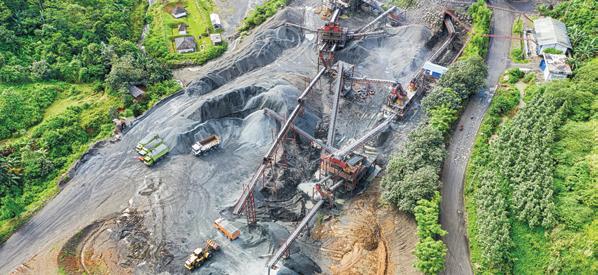
Confirm that you will be able to access reliable electricity to store your treatment on arrival on site. If you are working in Papua New Guinea (PNG) for example, this may not be available.
WHAT TO DO IF I HAVE A BLEED, INJURY OR SERIOUS ACCIDENT?
If you can administer your own treatment, start with having Replacement treatment as soon as possible.
If you can’t administer your own treatment, perform Rest, Ice, Compression & Elevation in the first instance and then seek medical attention. If there are paramedics at your site, they may be able to administer this for you if there is a clear plan in place.
Some employers, if you have declared your bleeding disorder ask for you to get a written plan/letter outlining your care if you should need treatment.
If you have not declared your medical condition, ensure you have an emergency/ABDR patient card. This can be provided by your HTC. This card gives initial direction for dosing if you have been in an accident or require major surgery. It also provides Emergency Departments with contact details for your HTC, especially if you are in another state, where you may not be known.
Depending on the seriousness of the injury, you may be evacuated to the closest hospital. Remember not all hospitals in Australia will have all treatment products available, so good planning is important prior to experiencing any emergency situations. You will need to see a doctor to get a medical certificate if you need to stop work due to injury and will also need a clearance certificate/letter to return on site.
If you have an injury, it is recommended you contact your home HTC as soon as possible, remembering that if you have travelled interstate or internationally, other teams will not have any or all information about you.
REMEMBER!
The important thing to remember in working as a FIFO employee, is you should consider all possible scenarios - whether this is a minor accident or major site disaster, or emergency surgery (for example appendicitis).
The further away you are from treatment and the greater the delay to getting to treatment, the more significant bleeding can be over time.
MORE INFORMATION
Visit the HFA website for more information on:
• Travel: www.haemophilia.org.au/bleeding-disorders/travel
• Disclosure at work: www.haemophilia.org.au/telling-others
Thanks to Sandra Lochore and Lara Olsen, Clinical Nurse Consultants at the Haemphilia Treatment Centre at the Fiona Stanley Hospital, Perth, Western Australia, other Australian Haemophilia Nursing Group nurses and patients who are FIFO workers who have given us advice or explained their experiences.
Stock image: Tom Fisk for Pexels.com
Beryl Zeissink is Clinical Nurse Consultant –Haemophilia at the Queensland Haemophilia Treatment Centre, Royal Brisbane & Women’s Hospital
15 National Haemophilia 225, March 2024
Mental health and support
Nicoletta Crollini
Starting the new year can be a time of reflection about what’s going well and what’s troubling us in our lives.
I thought it might be useful to focus on mental health and how to access supports considering:
• 1 in 5 Australians have experienced some form of mental health disorder in the past 12 months.
• 1 in 2 Australians will experience a mental disorder in their lifetime.
• Younger males aged 16 to 24 experience the highest rates of mental disorders.1
It is also worthwhile noting that the haemophilia and inherited bleeding disorder community is not exempt from dealing with mental health issues, with an estimated 2 out of every 5 people with haemophilia dealing with depression and/or anxiety.2
Raising awareness of the various mental health supports and services that anyone can access is
important to ensure people always know where and how to seek the help and support needed.
HOW TO SEEK SUPPORT?
24/7 Phone services and websites
There are plenty of services that are available to provide instant support to anyone dealing with a mental health issue or crisis. Below is a list of services that can be contacted to talk through what is happening in your life as well as link you in with long term supports.
Contact your Haemophilia Treatment Centre
You can contact your local HTC and connect with the psychosocial worker at the Centre to talk through what is happening. If needed, the psychosocial worker can connect you with long term support and localised mental health services.
16 National Haemophilia 225, March 2024
SERVICE Beyond Blue Headspace (NB .org.au not .com) Kids Helpline Lifeline CONTACT 1300 224 636 Find local centre online 1800 551 800 13 11 14 WEBSITE www.beyondblue.org.au www.headspace.org.au www.kidshelpline.com.au www.lifeline.org.au WHO FOR? For everyone For young people and parents For kids, young people and parents For everyone

Talk with your GP
You can also visit your general practitioner (GP) who can complete a Mental Health Treatment Plan with you, which is a tailored plan that links you in with specific mental health support services.
• A Mental Health Treatment Plan will allow you to initially access 6 individual psychological appointments that are subsidised through Medicare.
• If more sessions are needed, you can discuss this with your GP to access more Medicare subsidised psychological appointments.
• Through a Mental Health Treatment Plan, you will be able to access a range of psychological support specialists such as psychologists, social workers and occupational therapists to assist with your mental health care needs.
I hope you find this information useful, and I encourage anyone who is struggling with any mental health issues to seek the support they need.
REFERENCES
1. Australian Institute of Health and Welfare (2020) Mental health, AIHW, Australian Government, accessed 24 February 2022.
https://www.aihw.gov.au/reports/australias-health/mental-health
2. Al-Huniti A, Reyes Hernandez M, Ten Eyck P, Staber JM. Mental health disorders in haemophilia: Systematic literature review and meta-analysis. Haemophilia 2020; 26(3),431-442.
https://doi.org/10.1111/hae.13960
This article is adapted with permission from a previous article in the HFNSW newsletter: Crollini, N. Managing your mental health and supports. Factor Matters, 2022 March (49):7.
Stock image: Tony Schnagel for Pexels.com
Nicoletta Crollini is Haemophilia Social Worker at the Royal Prince Alfred Hospital, Sydney.
17 National Haemophilia 225, March 2024
Women and peer support
Lauren Green, Haemophilia Foundation Queensland Manager, spoke to Suzanne at HFA about HFQ’s work to develop peer support for women.
WHY PEER SUPPORT FOR WOMEN?
Growing up with haemophilia in the family, Lauren had been associated with Haemophilia Foundation Queensland (HFQ) since she was a little girl, but it wasn’t until she received a diagnosis herself that she became more aware of the needs of women and girls.
‘My brother was diagnosed with haemophilia when he was 11 months old and my parents were on the HFQ Board. Genetic testing for our family mutation wasn’t available until I was in my mid-20s and it was only then that I was formally diagnosed.
‘After that I was having lots of conversations in my roles on the Board with women who were having bleeding issues but didn’t have an official diagnosis. It was just something that wasn’t talked about because it was classed as “women’s issues” and swept under the rug.’

ACTIVITIES FOR WOMEN
HFQ decided to hold an activity that was open to any women affected by a bleeding disorder, whether they had a bleeding disorder, were a carrier, parent or partner. It was a morning tea at a local café and was so successful that it has continued quarterly over the last 7 years.

‘We just called it “women’s brunch” to keep it simple and informal.
‘Part of the thinking with “women’s brunch” was to have the women focus on themselves. We had run carers workshops. I wanted it to be a really relaxed environment so that women could open up but also give them a break from their caring role, if that’s what they were in, or being a parent. To have a moment to talk to other people in the same situation in a non-clinical setting.’
In a comfortable informal environment, the conversations were open and provided good opportunities for peer support and education.
‘The women were saying “oh, I just thought it was just a heavy period, I thought it was normal to have nosebleeds all the time.” Then we found that in having the conversations with women who were deemed “just a carrier” or had a child with haemophilia but hadn’t been tested themselves, that they were going and getting tested and finding out that they had low factor levels.’
18 National Haemophilia 225, March 2024
Lauren (right) with women members
HFQ has tried a few different types of activities to engage and support women:
Workshop-based activities rather than a sit-down lunch every 6 months.
‘These are fun activities that encourage a wider group of women to attend and different conversations – and are generally types of activities that appeal more to women than men. For example, paint & sip – having a drink and a cheeseboard while an artist teaches you how to make a textured painting on a canvas. We are thinking of candle-making for our next activity.
‘It’s such a relaxed environment that conversations happen organically. So, women would start conversations about what’s your connection and then share experiences of bleeding.
‘We had a lot of women come to the workshop activity who wouldn’t normally come to the brunches because it might be a little threatening if you were new to the community or you haven’t been to one before. There have been a lot of connections made in those sessions and then women talk again outside the session and have that peer support.’
Massages at community camps are popular with women to relax and also give them personal time separately from their children.
‘A lot of women take the massages up and then come out and have a chat to us afterwards.’
Carer lunches where the carers are provided with support to care for the person with a bleeding disorder while they are at lunch.
‘The carer lunches are really great for the women who just don’t get a break. They have a child or a partner with haemophilia and they are in that caring role constantly, which can be quite draining, so we give them an opportunity to have some time to themselves and be guilt free.’
WHAT WORKS?
What makes an activity more women-friendly?
Lauren shared her thoughts:
• Face-to-face with a relaxed feeling
• Suiting the timing to women’s commitments
‘We usually run the activities on Sundays midmorning to lunchtime because a lot of the women are mums and their kids have sport on Saturdays. And if they are working, we don’t want to exclude them.’
• Finding a way to come to them, a convenient venue
• Environments that are children-friendly, eg have a play area for children if you can’t organise baby-sitting
• Activities that are fun and where women can step right out of the caring role
• Keep the cost low
• Treats like a donated hamper door prize or little chocolates
• A private environment, eg a closed function room or booking out a whole space so you are not sharing it with others
• Using all communication channels to promote the activities: HFQ magazine, email, SMS, social media

OVERCOMING TABOOS
The conversations at the women’s peer support activities have had a very noticeable impact on women’s understanding of their bleeding, and many have now followed up with diagnostic testing for a bleeding disorder.
Lauren reflected that women often struggled to discuss their bleeding in other environments. It’s a common sentiment among males that gynaecological discussions are too much information and they ‘don’t want to know about that’, sometimes even in bleeding disorders community groups or in women’s own family.
19 National Haemophilia 225, March 2024
HFQ activities have been developed to offer private spaces and small break-away groups so that women are not as self-conscious about discussing personal issues. Conversations about bleeding are often started by more confident community leaders such as Lauren.
‘Women are more comfortable talking about their periods and bleeding with other women. I will openly talk about it to start the conversation. I’ll talk about my experience with childbirth or with my periods before I was diagnosed compared to now that I have treatment. And that gets rid of the awkwardness.
‘The open discussions have removed the stigma for a lot of women, especially the older ones, who said we just didn’t talk about periods or bleeding. It was so taboo you just didn’t discuss it and you certainly didn’t go to the doctor about it. They are saying now, “I wish I had been to a doctor and I am telling the younger generations that’s not normal, that’s what I was like. It’s probably a genetic thing, go and get tested.”
‘Most women think they just have to keep going and tough it out with all their existing commitments in spite of their bleeding – with their partner, their family, their work. And if you are having a conversation I can say, yes that was me, but then I went to see the haematology team and now I’ve got treatment and I’ve got so much more energy because I’m not iron deficient every month. I’m not having all these struggles. I can live pretty much a normal life.’
Messages are clear and simple:
‘I know you’re in a caring role for your child, but your health matters too.’
‘It’s OK go to a doctor if your bleeding isn’t normal. You’re not alone – this is happening to a lot of women.’
EDUCATING HEALTH PROFESSIONALS
The women’s peer support groups are also a good opportunity to give women the skills and the tools to educate the other health professionals who care for them and may need to be aware of their bleeding disorder.
‘We have the informal conversations first, then give women the HFA Female Factors booklet and the links to all the HFA information. We also point them
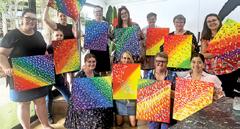
to the Let’s Talk Period self-assessment tool (https://letstalkperiod.ca) , which is a really good resource from Dr Paula James in Canada for showing what’s not normal and when to see your GP.
‘One of the hardest things is educating your other health professionals – your GP, emergency workers, the ones you are more likely to come across than your haematology team, unless you’re having major issues.
‘I also have a lot of conversations with women about when you are talking to your GP, make sure you are educating them as much as you can. Frontline workers can’t know everything. And there hasn’t been a lot of education for GPs and specialists on how women bleed, even now.’
Using tools like the ABDR Patient Card/emergency card can be valuable and HFA education resources can help to explain and support the women’s experience. GP education sessions, like those run by the Queensland HTC, are also important for getting the message out more widely among health professionals – HFQ sponsors these and is invited to give a presentation on the personal perspective of living with a bleeding disorder.
Thanks to Lauren for sharing her experiences of women’s peer support activities.
MORE INFORMATION
Visit the HFA website www.haemophilia.org.au to:
• Find out more about The Female Factors project and access the women’s education resources on the HFA website
• Contact your local Haemophilia Foundation for information about women’s peer support activities. Contact details for all Foundations are linked on the HFA website, or you can go directly to your Foundation.
20 National Haemophilia 225, March 2024
Displaying the results of the women’s paint ‘n sip activity
HFA has a new website
Over the past 12 months the HFA team, together with our website developer, Heartburst, have been hard at work designing and building a brand-new website for haemophilia.org.au. This has been no small undertaking! With thousands of pages worth of content to be moved and re-organised, you can imagine the work involved.
We have big plans for our website moving forward, and this project to modernise it was only the first step. In the meantime, you can still find all of the same great content, just in beautiful new packaging.
WHAT’S NEW?


Improved navigation – we’ve split up the navigation into two levels to make it easier for you to find what you’re looking for. We’ve highlighted our content on ‘Living with a bleeding disorder’ and updated the ‘Publications’ area to become ‘Resources’.
Accessibility – we’ve added a new Accessibility Toolbar. Click the little red person button to the left of the screen to access it. You can use this tool to easily change font size, colours, and more.
Find a Resource – this is a new section of the website, enabling you to filter our News items, National Haemophilia articles and Personal Stories by topic. Please note it’s still under development – we will be adding all of our educational resources soon!
WHAT’S NEXT?
At the moment we’re going through and fixing any minor bugs and ensuring everything has come across smoothly in the changeover. Next on the list is to beef up the new Find a Resource section to make it easy for you to find all of HFA’s educational articles, booklets, fact sheets and more. We’re also updating the Personal Stories section to include all of the stories that have been shared to HFA’s youth site, Factored In.
WHAT TO DO IF SOMETHING’S BROKEN?
If you notice something on the site isn’t working, or an old link you have bookmarked is now loading a ‘404 Error’ page, please let us know at: hfaust@haemophilia.org.au
Thank you for your patience while we upgrade the website. If you have any questions, thoughts, or would like to provide feedback, please email us on: hfaust@haemophilia.org.au

Visit HFA’s new website. Go to www.haemophilia.org.au or scan the QR Code.
21 National Haemophilia 225, March 2024
image: Icon by Freepik
Stock

Youth taking on the future
In 2023 Ben Ingliss received an HFA Volunteer Award. He has been very involved in the Haemophilia Foundation Victoria (HFV) ‘Blue Shirts’ youth leadership program for many years and talked to HFA about his experiences and hopes for the program.

Hi, I’m Ben. I have moderate haemophilia A and I have been a youth leader for 6 years.
How did the Blue Shirts start?
At HFV we’ve been building a youth leadership team. It started off initially that we noticed we were losing people from our camp programs when they reached that teenager/young adult age. And we noticed that we weren’t really giving them a space in these programs. At the camps the kids go and do the kids thing and the adults go and do the adult thing and the teenagers were in this awkward in-between space. They weren’t feeling engaged and they didn’t feel like they had a place, so they weren’t showing up. I was approached about this and I had some ideas, and we put together a team with a couple of us in that age range, who love the community and love the programs, but wanted to be getting a little more out of it.
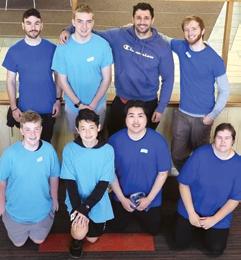
At HFV we’ve been building a youth leadership team.
How does it work now?
Over the years the youth team has grown and expanded. Initially we would just turn up and help out but now, collaboratively as a team, we’ve made a code of conduct, a handbook, a set of expectations, different roles for the team, and how we want to interact in different programs. We have lots of different ideas that we’re running through the HFV Committee to increase youth engagement.
What’s different about it?
The really powerful thing about it is that the youth team isn’t this thing that HFV is doing for the youth. We’ve been given a space to make something for ourselves where we can make decisions that are going to affect us, and we can have input into HFV. That’s important for me and the younger members of the team, because we’re going to be running this community someday.
22 National Haemophilia 225, March 2024

Being part of the Youth Team is also really fun and rewarding. We’ve been given a space to make something for ourselves.
How does it affect the future?
It gives us a chance to build our capacity and practice the sort of skills that are going to be necessary to keep the community strong and deal with the developing needs of the bleeding disorder community, which are changing so quickly these days.
How does the Youth Program grow and develop?
A major goal for me is the longevity of the programto set up something for when I need to step down and someone else is going to step up to take that role. So, part of the planning of the team has been setting up a hierarchy.
You’ve got younger people who haven’t really been on a program before. They’re testing out if they want to be on the team and practicing and being mentored by other people.
Then we’ve got people who’ve been to a couple of programs and they know the deal. They’re helping the little ones learn.
And then people higher up who are planning programs and building that documentation.
And that gradual build up will hopefully result in everyone moving up the chain within the team to the point that anyone really can take over for me if they want to.

How does it help with work skills?
We’re really trying to build this to be something that members of the team can put on a resume – ‘I think I’m really good for this job because I’ve been on this team and I’ve learned these skills’. A big part of leadership is getting that chance to learn and practice and realise your strengths and your weaknesses.
What’s best about the youth team?
Being part of the Youth Team is also really fun and rewarding.
We’re already seeing the 10-year-old kids at camp talking excitedly about hoping to get onto the team at some point. We recently had a youth camp where we had between 18 and 21 participants. it’s a real testament to these guys and girls with bleeding disorders – and siblings – in the youth team. They are role models. And there’s something really powerful in getting to interact with people of similar ages where you can relate to their experience. Even with kids five years younger, our experience is already so different. It’s great program and I’m really proud of what we’ve achieved together from it.
Camp photos supplied by HFV and reproduced with permission.
Find out more
Ask your local Foundation about camps and their youth activities. If you don’t have their contact details, you can find them on the HFA website –www.haemophilia.org.au
23 National Haemophilia 225, March 2024 Ben’s story
CALENDAR
World Haemophilia Day
17 April 2024
wfh.org/world-hemophilia-day
WFH 2024 World Congress
Madrid, Spain
21-24 April 2024
wfh.org/congress
Bleeding Disorders Awareness Month
October 2024
ACKNOWLEDGEMENTS
Haemophilia Foundation Australia (HFA) acknowledges funding grants received from the Australian Government.
We thank the individuals, philanthropic trusts and companies which have made donations to HFA, and the following companies for sponsorship of education programs, conferences or disease awareness programs run by the Foundation for the bleeding disorders community.
HFA acknowledges the grants and/or conference sponsorship from the following pharmaceutical companies:
BIOMARIN | CSL BEHRING | NOVO NORDISK
PFIZER AUSTRALIA | ROCHE | SANOFI GENZYME
www.haemophilia.org.au/BDAM Look out for WFH Congress 2024 reports in the next edition!
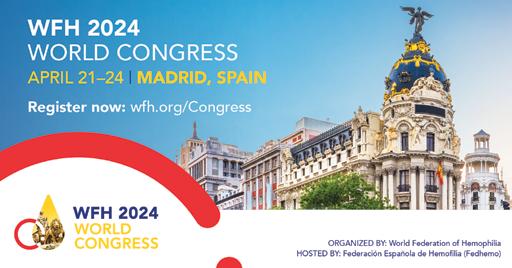
NATIONAL HAEMOPHILIA is a publication of Haemophilia Foundation Australia. Every effort is taken to ensure accurate and relevant content, however opinions expressed in NATIONAL HAEMOPHILIA do not necessarily reflect those of the Foundation or the editor, nor is any information intended to take the place of advice from a qualified medical practitioner or health professional.
Haemophilia Foundation Australia does not endorse or assure the products, programs or services featured in NATIONAL HAEMOPHILIA and does not make specific recommendations for any products, programs or services.
We welcome reproduction of articles or quotations from NATIONAL HAEMOPHILIA on the understanding that acknowledgement is made of NATIONAL HAEMOPHILIA as the source.
Haemophilia Foundation Australia acknowledges the Traditional Owners and Custodians of Country throughout Australia, the land, waters and community where we walk, live, meet and work. We pay our respects to Elders past and present and extend that respect to all Aboriginal and Torres Strait Islander peoples.
24





 Gavin Finkelstein
President, Haemophilia Foundation Australia
Gavin Finkelstein
President, Haemophilia Foundation Australia

























